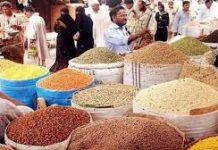By Muhammad Luqman
Pakistan’s population has registered a staggering increase of 57 percent over the last 19 years as total count reached 207.8 million mark, according to the provisional results of the 6th Population and Housing Census , presented in the Council of Common Interests in the capital, Islamabad on Friday.
According to the summary results, the country’s predominant majority 63.6% (132.189 million people) still lives in rural areas. This ratio was 65.6% in 1998 when the last headcount was conducted. Compared with the results of the last census there was a 57% increase in the population at an annual rate of 2.4%.
The CCI –the constitutional body headed by the prime minister with four chief ministers in the chair, approved the provisional summary results . However, the final results will be available next year.
The results are exclusive of Azad Jammu & Kashmir and Gilgit-Baltistan. The Pakistan Bureau of Statistics conducted the census in these two territories but did not release their results.
The urban population stood at 75.58 million, which is roughly 36.4% of the country’s population. In 1998, the share of urban population was 32.52%.
One of the surprising results was reduction in share of women in the total population. The female population stood at 101.314 million, which was 48.8% of the total headcount, according to the 2017 results. The male population increased to 106.449 million or 51.2%. Meanwhile, there were only 10,418 transgender persons (0.05%).
Punjab still remains the most populated province, as its population stood at 110.1 million or 52.94% of the total population. The province’s population in past 19 years increased 36.4 million, which was 49.4% higher than 1998 statistics.
Sindh remained second most populated province with 47.886 million people, which is 23% of the total population. Sindh’s population grew by 57.3% or 17.44 million during past 19 years.
Khyber-Pakhtunkhwa’s population stood at 30.523 million –which was 14.69% of the total population. Its population grew by 12.78 million or 72% — the second maximum increase.
Balochistan’s population stood at 12.344 million or 5.94% of the total population. In past 19 years, its population grew by 5.8 million or 88% — the maximum increase in the population of any federating unit in terms of percentage.
Islamabad Capital Territory population stood at two million, which was 1.2 million higher than the 1998 census. In terms of percentage, it grew by 149%.
The population of Federally Administrated Tribal Areas stood at 5.1 million. There was a 1.8 million increase in the population of the autonomous region.
The PBS had conducted the exercise in two phases across Pakistan under the supervision of the military. The population results will be used to determine federating units’ share in federal resources, allocations and delimitation of National Assembly and provincial assemblies seats and determination of provincial job quotas.















